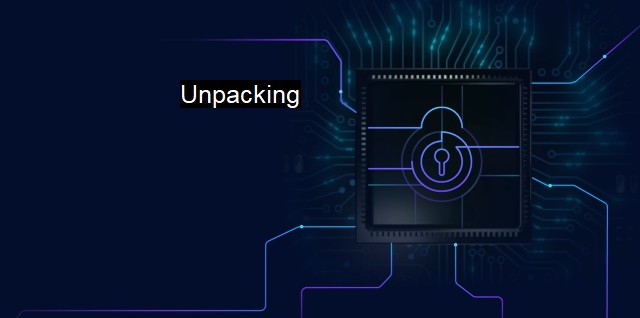What is Unpacking?
The Art of Unpacking: Closer Look at Deconstructing Cybersecurity Threats
Unpacking refers to a technique commonly used in cybersecurity to decrypt or decompress the code and data associated with malware or software. Malware authors frequently use packing to obfuscate their code's original content, making it more challenging for security researchers or antivirus programs to analyze or detect the code. Thus, unpacking becomes critical in these scenarios to reveal hidden malicious functionalities and protect systems from potential malware attacks.Coupled with rapid advancements in technology, threats in the cybersecurity landscape have grown in both sophistication and number. It is common to find malicious actors creating codes that are potent, elusive and, if left undetected, can cause substantial harm. These codes are usually packed or encrypted, preventing antivirus applications and cybersecurity experts from detecting and analyzing them.
A packed piece of software has its code and data compressed or encrypted in some fashion. The purpose of this packing, largely is to confuse antivirus software, making the malicious code blend with the rest of the system, thus remaining undetected.
The foremost step that software takes upon being run is to unpack or decrypt itself into memory, becoming whole again. This concept is also applicable to legitimate programs compressed or encrypted to minimize disk space or provide better safety. But in the case of a malicious program, once unpacked, it is free to cause harm as the protective shields of the security measures cannot contain it any longer.
Consider unpacking as the process of undoing the packing method. It involves the piece-wise and logical deconstruction of the code in an effort to expose the underlying, often malicious, layer. The process of unpacking malware requires specialized techniques, experts, and tools.
Usually, code unpacking is a complicated process for several reasons. First, detecting whether a piece of software has been packed is demanding since it's largely concealed and anomalous amongst the many lines of code in software. because numerous packing algorithms exist, it may be difficult to recognize the specific version in use. The program being unpacked needs to be studied meticulously to understand its intrinsic traits and fully unpack it.
The benefits of unpacking are evident in enhancing cybersecurity measures. Unpacking allows cybersecurity analysts and antivirus software to understand the inner workings of the malware and enact appropriate preventive measures. If successful in unpacking a packed malware, these protective programs get to glimpse into the modus operandi of malware, understanding how it behaves, what it alters, and its impacts.
Performed in a controlled environment, unpacking reveals the native code which can be useful in enhancing the quality of threat intelligence. Unpacked malware equips analysts with the knowledge necessary to create more precise detection rules, instigate advanced preventive measures, develop remediation capabilities, and contribute to overall cybersecurity protections.
While unpacking represents an effective methodology of determining the presence and sophistication of malware, it also provides a formidable challenge to cybersecurity professionals. Contemporary malware creators are becoming smarter and swifter as they concoct packing processes that sophisticate and expedite at almost a similar rate as technology advancements. An efficient approach is developing an in-depth understanding, adequate tools, and refining skills to be a step ahead. The unpacking process is a continuous journey, necessary not only for fighting malicious programs but also for the progress in information technology.
"unpacking" in cybersecurity refers to decrypting or decompressing software, showcases an essential strategy adopted by cybersecurity experts and antivirus software in deciphering codes and actively handling malware threats. It allows malicious codes to be detected and decoded, subsequently revealing their harmful impact on systems. It contributes significantly to an increasing number of prevention, detection, and remediation efforts in the larger context of cybersecurity.

Unpacking FAQs
What is unpacking in the context of cybersecurity and antivirus?
Unpacking is the process of extracting the contents of a packed or compressed file. It is an important technique used by antivirus software to analyze and detect malware that might be hidden in such files.How does unpacking help in detecting malware?
Unpacking allows antivirus software to analyze the contents of a file by decompressing it and examining the individual components. This makes it easier to identify suspicious code or behavior that might be indicative of malware.What are some of the challenges associated with unpacking for cybersecurity and antivirus?
One of the challenges of unpacking is that malware authors often use obfuscation techniques to make it more difficult to analyze the contents of their files. This can include encrypting the contents, using anti-debugging measures, or packing the file multiple times.Are there any risks associated with unpacking files for cybersecurity and antivirus purposes?
Unpacking files can potentially expose the system to malware if the file being unpacked is malicious. To mitigate this risk, antivirus software should be used to perform the unpacking process in a secure environment with appropriate security controls in place to prevent the malware from spreading.| | A | | | B | | | C | | | D | | | E | | | F | | | G | | | H | | | I | | | J | | | K | | | L | | | M | |
| | N | | | O | | | P | | | Q | | | R | | | S | | | T | | | U | | | V | | | W | | | X | | | Y | | | Z | |
| | 1 | | | 2 | | | 3 | | | 4 | | | 7 | | | 8 | | |||||||